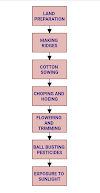ADVANCES IN SPINNING
- INTRODUCTION:
In today technology, many spinning system are used commercially to produce spurn yarns with a wide range of values of characteristics. Among these systems,ring spinning enjoys the greatest diversity and highest quality level. Ring spinning has been able to supplant almost all other conventional spinning methods and has proved very resistant to inroads by the newcomers. This can be attributed mainly to its flexibility universal applicability and yarn quality.- WHAT IS SPINNING:
In today technology, many spinning system are used commercially to produce spurn yarns with a wide range of values of characteristics. Among these systems,ring spinning enjoys the greatest diversity and highest quality level. Ring spinning has been able to supplant almost all other conventional spinning methods and has proved very resistant to inroads by the new corners. This can be attributed mainly to its flexibility universal applicability and yarn quality.- SPINNING PROCESS:
Spinning process basically consists of three stages :1. ROLLER DRAFTING
2. BINDING
3. WINDING
OPEN END SPINNING:
• FEATURE'S:
1. Drafting
2. Fibre transport
3. Fibre alignment
4. Cleaning(if necessary)
5. Fibre condensation
6. Twisting
7. Yarn removal
8. Winding
• ELEMENTS:
-a device for draping the fibrous mass into individual fibres,
-a means of transporting the fibres to the yarn end,
-a device for collecting the separated fibres onto the yarn end in a manner that enables the correct yarn count to be obtained,
-a device for rotating the yarn end to insert a twist into be collected fibres,and
_a means of winding the yarn onto the package.
• ADVANTAGES:
-Lower power consumption per unit quantity of yarn produced.
-Higher speed of twist insertion resulting in very high yarn delivery speed.
-A significant resulting increases in productivity.
-Larger delivered package side.
-Emanation of some processes such as roving and winding.
-More uniform yarns.
ROTOR SPINNING:
 |
| ROTOR SPINNING |
To provide a more economical spinning system than conventional ring spinning through higher productivity,
To produce yarn of quality that matches of the conventional ring spinning.
PRINCIPLES:
1. a feed roller and feed plate
2. a saw tooth or pin covered roller called an opening roller
3. a tappered tube known as fibre transport channel
4. a shallow cup called as rotor
5. a flanged tube facing the rotor base and co axial to the rotor, termed the drafting tube
6. a pair of delivery roller that feed the spurn yarn to the package build device.
FRICTION SPINNING:
 |
| FRICTION SPINNING |
-The main drawback is lower yarn strenght. poor fibre orientation renders the friction spun yarns relatively weak.
-The extent of orientation and buckling is greater with longer and finer fibres.
-The twist variation from surface to core is quites high. This is another reason for the low strenght or friction yarn spun .
-The count range is limited and it is not possible to produce fine yarn .
-Friction spun yarns have a higher tendency to snarl .
-Yarns unevenness and imperfections also increase .
- OTHER SPINNING SYSTEMS:
1.ELECTROSTATIC SPINNING.2.AIR VORTEX SPINNING.
3.TWIST SPINNING.
4.REPCO SPINNING ( SELF TWIST ).
5.WRAP SPINNING.






0 Comments